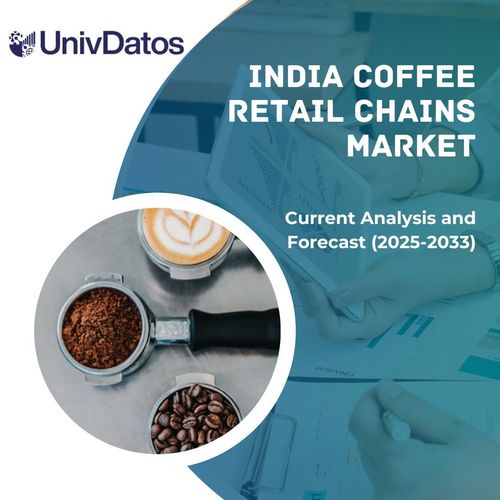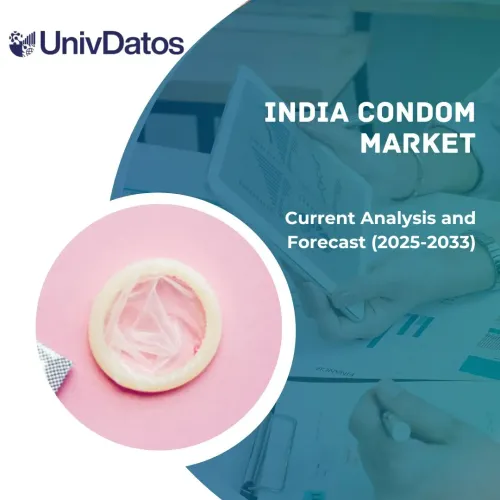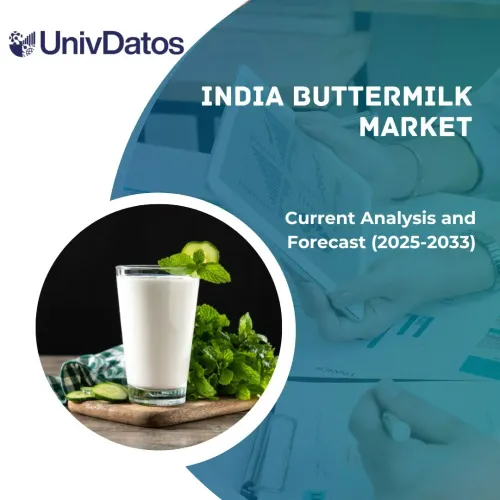- Home
- About Us
- Industry
- Services
- Reading
- Contact Us
Food Robotics Market: Current Analysis and Forecast (2021-2027)
: Emphasis on Type (Articulated, Cartesian, SCARA, Parallel, Cylindrical, Collaborative Others); Payload (Low, Medium, High); Function Type (Palletizing, Packaging, Repackaging, Pick & Place, Processing, Others); Application (Meat, Poultry, & Seafood, Processed food, Dairy products, Fruits & Vegetables, Beverage, Bakery & confectionery, Others); Region/Country
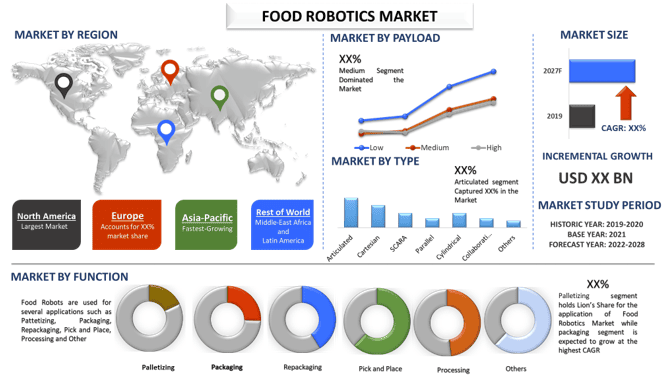
Global Food Robotics Market was valued at US$ 2.1 Billion in 2020 and is anticipated to reach US$ 4.9 Billion by 2027 displaying an elevated CAGR of 13% over the forecast period (2021-2027). The demand for food robotics is witnessing an uptick on account of the decreasing labor productivity, labor working hours, and the total output as well. Deployment of robotics helps in increasing output, timesaving, smooth, and efficient operations as well. As per the U.S. Bureau of Labor Statistics, food manufacturing employee around 1.6 million workers. Furthermore, with surging mishappening during food processing and other operations, there is a greater demand for food robots. In 2018, the incident rate for food manufacturing workers in the U.S. was 4.2%. In which Burns, cuts, and slips are among the most common types of injuries in food processing plants.
As per the United States Department of Agriculture (USDA), food and beverage manufacturing plants accounted for 15.8% of the value of shipments and 14.7 percent of all employees from all U.S. manufacturing plants in 2019. Growing demand for processed and packaged food in the region acting as a growth catalyst to the industry. 80% of Americans’ total calorie consumption comes from store-bought foods and beverages (packaged and unpackaged). Moreover, the rise in work-related fatalities in the region is also proliferating the growth of the demand. As per the U.S Bureau of Labor Statistics, the number of fatalities increased from 40 in 2016 to 49 in 2019.
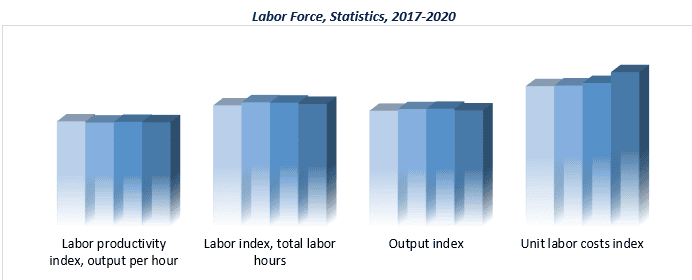
ABB Group, Kawasaki Heavy Industries Ltd., Rockwell Automation Incorporated, Mitsubishi Electric Corporation, Fanuc Corporation, Yaskawa Electric Corporation, Kuka AG, Seiko Epson Corporation, Staubli International AG, and Universal Robotics A/S. etc, are some of the prominent players operating in the Food Robotics market. Several M&As along with partnerships have been undertaken by these players to facilitate customers with hi-tech and innovative products.
Insights Presented in the Report
“Amongst Type, Articulated segment holds the major share”
Based on the Type, the market is fragmented into Articulated, Cartesian, SCARA, Parallel, Cylindrical, Collaborative and Other. The articulated segment of the Global Food Robotics market grabbed the major market share and dominated the market. The segment captured around XX% market share and generated USD XX Mn in 2020 and is expected to grow at a CAGR of XX% during the forthcoming years
“Amongst Payload, Medium Payload segment to dominate the market during the forecast period”
Based on the payload, the market is mainly fragmented into Low, Medium, and High. The medium payload segment grabbed major market share and captured XX% market revenue in 2020. However, the low payload segment would emerge in the forecast period and would witness the highest CAGR during the forthcoming period
“Amongst Function Type, Palletizing segment grabbed Major Market share in 2020”
Based on function type, the market is fragmented into Palletizing, Packaging, Repackaging, Pick & Place, Processing and Others. The Palletizing segment grabbed major market share and captured XX% market revenue in 2020. However, the packaging segment would emerge in the forecast period and would witness the highest CAGR during the forthcoming period as well and would reach USD XX Mn by 2027
Amongst Application, Meat, poultry, & seafood segment grabbed Major Market share in 2020”
Based on Application, the market is segmented into Meat, poultry, & seafood, Processed food, Dairy products, Fruits & vegetables, Beverage, Bakery & confectionery products, and other applications (Convenience food & infant food). The Meat, Poultry, and Seafood segment grabbed XX% market share and gathered USD XX Mn in 2027. Moreover, this segment is expected to reach USD XX Mn by 2027 with a growth of XX% CAGR during 2021-2027
“North America represents one of the largest markets of Food Robotics market”
For a better understanding of the market dynamics of the Food Robotics market, a detailed analysis was conducted for different regions across the globe including North America, Europe, Asia Pacific, and the Rest of the world. North America dominated the market and generated revenue of US$ XX Million in 2020 owing to the change in lifestyle and growing demand for processed and packaged food.
Reasons to buy this report:
- The study includes market sizing and forecasting analysis validated by authenticated key industry experts
- The report presents a quick review of overall industry performance at one glance
- The report covers an in-depth analysis of prominent industry peers with a primary focus on key business financials, product portfolio, expansion strategies, and recent developments
- Detailed examination of drivers, restraints, key trends, and opportunities prevailing in the industry
- The study comprehensively covers the market across different segments
- Deep dive regional level analysis of the industry
Customization Options:
The Food Robotics Market can further be customized as per the requirement or any other market segment. Besides this, UMI understands that you may have your own business needs, hence feel free to connect with us to get a report that completely suits your requirements.
Table of Content
Research Methodology for the Global Food Robotics Market Analysis (2021-2027)
Analyzing the historical market, estimation of the current market, and forecasting the future market of the Food Robotics Market were the three major steps undertaken to create and analyze the demand for Food Robotics across major regions. Exhaustive secondary research was conducted to collect the historical market numbers and estimate the current market size. Secondly, to validate these insights, numerous findings and assumptions were taken into consideration. Moreover, exhaustive primary interviews were also conducted, with industry experts across the value chain of the Food Robotics market. Post assumption and validation of market numbers through primary interviews, we employed a top-down/ bottom-up approach to forecast the complete market size. Thereafter, market breakdown and data triangulation methods were adopted to estimate and analyze the market size of segments and sub-segments the industry pertains to. Detailed methodology is explained below:
Analysis of Historical Market Size
Step 1: In-Depth Study of Secondary Sources:
Detailed secondary study was conducted to obtain the historical market size of the Food Robotics through company internal sources such as annual reports & financial statements, performance presentations, press releases, etc., and external sources including journals, news & articles, government publications, competitor publications, sector reports, third-party database, and other credible publications.
Step 2: Market Segmentation:
After obtaining the historical market size of the Food Robotics market, we conducted a detailed secondary analysis to gather historical market insights and share for types, payload, function, and applications for major regions. Major segments included in the report are material type, application, and product. Further region and country-level analyses were conducted to evaluate the overall adoption of Food Robotics across the globe.
Step 3: Factor Analysis:
After acquiring the historical market size of different segments and sub-segments, we conducted a detailed factor analysis to estimate the current market size of Food Robotics. Further, we conducted factor analysis using dependent and independent variables such as Growing Demand for Processed and Packaged food, rise in disposable income, etc., A thorough analysis was conducted for demand and supply-side scenarios considering top partnerships, merger and acquisition, business expansion, and product launches in the Food Robotics industry across the globe.
Current Market Size Estimate & Forecast
Current Market Sizing: Based on actionable insights from the above 3 steps, we arrived at the current market size, key players in the Food Robotics market, and market shares of the segments. All the required percentage shares split, and market breakdowns were determined using the above-mentioned secondary approach and were verified through primary interviews.
Estimation & Forecasting: For market estimation and forecast, weightage was assigned to different factors including drivers & trends, restraints, and opportunities available for the stakeholders. After analyzing these factors, relevant forecasting techniques i.e. bottom-up/ top-down approach was applied to arrive at the market forecast about 2027 for different segments and subsegments across the major markets globally. The research methodology adopted to estimate the market size encompasses:
- The industry’s market size, in terms of value (US$) and the adoption rate of Food Robotics across the major markets domestically
- All percentage shares, splits, and breakdowns of market segments and sub-segments
- Key players in the Food Robotics market in terms of services offered. Also, the growth strategies adopted by these players to compete in the fast-growing market
Market Size and Share Validation
Primary Research: In-depth interviews were conducted with the Key Opinion Leaders (KOLs) including Top Level Executives (CXO/VPs, Sales Head, Marketing Head, Operational Head, and Regional Head, Country Head, etc.) across major regions. Primary research findings were then summarized, and statistical analysis was performed to prove the stated hypothesis. Inputs from primary research were consolidated with secondary findings, hence turning information into actionable insights.
Split of Primary Participants in Different Regions

Market Engineering
Data triangulation technique was employed to complete the overall market estimation and to arrive at precise statistical numbers of each segment and sub-segment of the Food Robotics market. Data was split into several segments & sub-segments post studying various parameters and trends in the areas of Type, payload, function, and application, of the Food Robotics market.
Main Objective of the Food Robotics Market Study
The current & future market trends of Food Robotics were pinpointed in the study. Investors can gain strategic insights to base their discretion for investments from the qualitative and quantitative analysis performed in the study. Current and future market trends were determined the overall attractiveness of the market at a regional level, providing a platform for the industrial participant to exploit the untapped market to benefit as a first-mover advantage. Other quantitative goals of the studies include:
- Analyze the current and forecast market size of Food Robotics in terms of value (US$). Also, analyze the current and forecast market size of different segments and sub-segments
- Segments in the study include areas of type, payload, function, and application
- Define and analysis of the regulatory framework for the Food Robotics industry
- Analyze the value chain involved with the presence of various intermediaries, along with analyzing customer and competitor behaviors of the industry
- Analyze the current and forecast market size of the Food Robotics market for the major countries
- The major region studied in the report includes North America, Europe, Asia- Pacific and Rest of the World.
- Company profiles of the Food Robotics market and the growth strategies adopted by the market players to sustain in the fast-growing market
Deep dive regional level analysis of the industry
Related Reports
Customers who bought this item also bought




